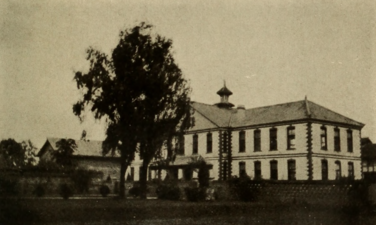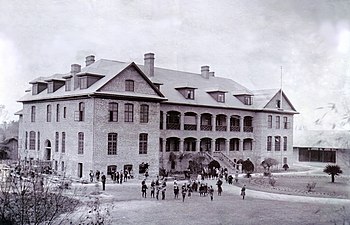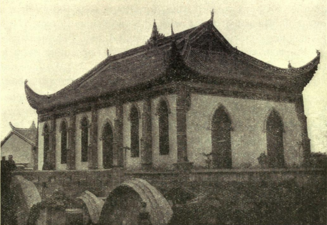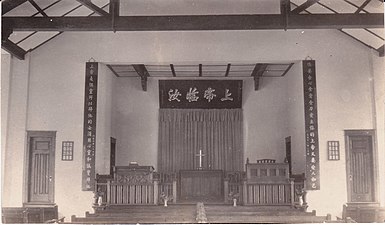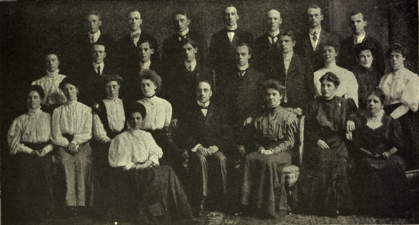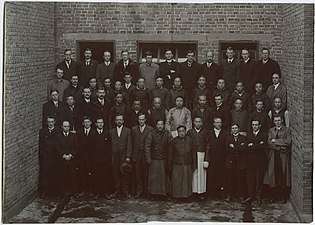History of Methodism in Sichuan
| Part of a series on |
| Methodism |
|---|
 |
|
|
Methodism in Sichuan refers to the history and implantation of Methodism in the Chinese province of Sichuan (formerly romanized as Szechwan, Szechuan, Sz-chuan or Sz-chuen; also referred to as "West China"). Methodism, along with Anglicanism, were the two largest Protestant denominations in that province.[1]
History
American Methodist Episcopal Mission

The first Methodist missionaries to reach Sichuan were those of the American Methodist Episcopal Mission (AMEM) led by Rev. Lucius Nathan Wheeler,[2] who arrived in Chungking in 1882. Their early efforts encountered strong resistance and riots that led to the abandonment of the mission. It was not until 1889 that these Methodists came back and started the mission again.[3]

The AMEM mission work concentrated within a diamond-shaped area with the cities of Chengtu, Suining, Tzechung and Chungking as bases.[4] Apart from being one of the four founding societies of the West China Union University in 1910,[5] the AMEM had several colleges, schools and hospitals in those above-mentioned cities, as well as an Institutional Church in Chengtu and a Lewis Memorial Institutional Church in Chungking.[6]

The Rev. Dr. Joseph Beech, a Wesleyan University graduate and member of Psi Upsilon and Phi Beta Kappa,[7] played an instrumental role in founding and running West China Union University. He served as its founding president and later its chancellor.[8]
Ailie Gale served as hospital administrator for five years at Chadwick Memorial Hospital in Tzechung beginning in 1941. She left in 1946 to reunite with her husband, as she recognized escalating political conflict.[9]
During the 1940s, the Church's work in the Chengtu area was directed by W. Y. Chen, one of the four Methodist bishops in China.[3][10]
Canadian Methodist Mission
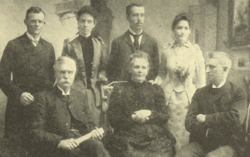
In 1891, a West China Mission group of the Missionary Society of the Methodist Church in Canada (MCC) was formed in Toronto, consisting of four missionaries and their wives. Two of the men were ministers (Virgil C. Hart, founder of the mission,[11] and George E. Hartwell), and two were doctors (Omar L. Kilborn and David W. Stevenson).[12] Before their departure, a farewell service was held in Elm Street Methodist Church, Toronto. They left Canada for China on 4 October.[13]

The party arrived in the provincial capital Chengtu the following year. Work began immediately in the capital, and two years later, in Kiatingfu,[14] with the establishment of mission stations in both cities.[15] The mission's first church and hospital were subsequently built in Chengtu. On April 16, 1893, the missionaries welcomed their first convert, a woman. She impressed the missionaries with her straightforward manner, a rare trait in a Chinese, and by her remarkable progress in learning to read.[16]
In 1895, a serious outbreak of anti-foreign agitation spread throughout the province. In Chengtu, all the MCC mission property was entirely destroyed; and all missionaries of all missions, Protestant and Roman Catholic alike, were thankful to escape with their lives.[17]

In 1897, the Canadian Methodist Mission Press was established in Kiatingfu, but was moved to the capital city of Chengtu in 1903. This press produced publications mostly in English, Tibetan, Chinese and Hua Miao, but also printed language lessons in French and German. In addition to printing for the various missions in the western province, a certain amount of work was done for local schools and non-missionary foreigners.[18] Notable among its printings was The West China Missionary News, first published in 1899, being the first and longest-running English-language newspaper in Sichuan province.[19]

In 1906, eight Victoria College students formed the Victoria Eight, nicknamed "The Missionary Gang" to China and Japan. They left Canada in November. Acta Victoriana celebrated their departure by publishing in the November 1906 issue the students' graduating photographs on the journal's frontispiece, and a poem titled "L'Envoi" by Edward Wilson Wallace, one of the Eight. Six of these men were sent to Sichuan, where they arrived in 1910 after two years of language learning.[20]
After 1900, eight more mission stations were established in Jenshow (1905), Junghsien (1905), Penghsien (1907), Tzeliutsing (1907), Luchow (1908), Chungking (1910), Chungchow (1911) and Fowchow (1913). The MCC missionaries travelled through the province building churches and residential compounds with missionary houses. They rented or bought local buildings to run services, prayer meetings and Bible study classes. They preached in markets and church halls, established day schools and boarding schools at the primary and high schools for both boys and girls, besides opening orphanages. The medical missionaries opened clinics, dispensaries, and hospitals.[21] They served in the province's Red Cross work during the years 1913–16.[22]

The MCC was one of the four mission societies responsible for the creation of West China Union University in 1910, together with American Baptist Foreign Mission Society (American Baptist Churches USA), American Methodist Episcopal Mission (Methodist Episcopal Church), and Friends' Foreign Mission Association (British Quakers).[5] There they opened their own Hart College, and the university's Medical and Dentistry Departments owed their success to these Canadian missionaries.[21] That same year (1910), the MCC took over Chungking district from London Missionary Society.[23]
In 1917, the Silver Jubilee of the founding of the West China Mission was celebrated among Canadian Methodists.[24] On May 27, 1918, the MCC had its first preparatory conference held at Junghsien. At this conference, the first local missionary was appointed and sent to the hill tribes northwest of Chengtu. The personnel of the conference included missionaries, evangelists, probationers, and lay delegates.[25]


By the end of 1921, the Methodists enrolled almost one half of the Protestant Christians in Sichuan.[1] Following the merger of the Methodist Church of Canada into the United Church of Canada in 1925, the latter assumed responsibility for the MCC. At that time, the MCC was the largest mission of the newly-founded Church. There were 10 central stations, 8 hospitals, 10 dispensaries, 10 higher primary schools, 2 middle schools and 126 lower primary schools, as well as 214 Canadians, both men and women, working as mission staff. Each station executed missionary work in three forms: evangelistic, educational, and medical. As a whole, the mission created a Christian community of about 10,000 people. In 1927, many Canadian missionaries were ordered to evacuate Sichuan due to communist uprisings and the subsequent Chinese Civil War. This evacuation led to a number of staff resignations which caused a decline in the West China Mission work.[26]
By 1934, the MCC had joined the Church of Christ in China (CCC);[27] an annual general meeting of the CCC's Szechwan Association was held on February 9, 1939.[28]
Current situation
After the communist takeover of China in 1949, missionaries were expelled, most church activities were banned, and all mission schools and hospitals were taken over by the government.[27] Protestant Churches in China were also forced to sever their ties with respective overseas Churches, which has thus led to the merging of all the denominations into communist-sanctioned Three-Self Patriotic Church.[29]
The history of Canadian West China Mission was largely forgotten by both Canada and China, and once suppressed by Chinese government not keen to acknowledge the work of foreign faith workers, until, according to Nathan VanderKlippe's report in 2017, "the past few years, [...] the story of the West China Mission is now being revived with a caveat. The missionaries are not referred to as such. They are, instead, called 'volunteers'."[30]
Gallery
-
The first Canadian Methodist Mission Press at Kiating, before 1903
-
The new Canadian Methodist Mission Press at Chengtu, April 1905
-
Canadian Methodist Hospital at Chengtu, before 1917
-
The Canadian School of the West China Union University, Chengtu, c. 1918
-
Canadian Methodists' Hart Memorial College at the West China Union University
-
Canadian Methodist Church at Junghsien, before 1911
-
Canadian Methodist Church at Tzeliutsing, before 1920
-
Canadian Methodist Church at Chungking, before 1920
-
Interior of the Canadian Methodist Chapel at Chengtu, decorated for Christmas, before 1903
-
Six of the Victoria Eight, l to r: N. E. Bowles, E. W. Morgan, C. J. P. Jolliffe, W. E. Sibley, H. D. Robertson, and E. W. Wallace, sailed in 1906
-
New mission group of the MCC, sailed in 1908
-
Forward Movement, Missionary Conference, Chengtu, 1908
-
Canadian West China Mission Annual Conference, Chungking, 1914
-
Funeral of one of the West China Conference pastors held at an American Methodist Episcopal church in Chungking, between 1900 and 1930
-
American Methodist Episcopal Church tower, Chungking, between 1900 and 1930
-
American Methodist Gospel Church at Chungking in 2019
See also
References
- ^ a b Stauffer 1922, p. 228.
- ^ Hart 1917, p. 181.
- ^ a b Baker 1946, p. 19.
- ^ Baker 1946, p. 18.
- ^ a b "West China Union University". library.vicu.utoronto.ca. Retrieved 21 September 2022.
- ^ Baker 1946, pp. 37, 46.
- ^ Russ, Johanna. "Beech, Joseph, Class of 1899". divinity-adhoc.library.yale.edu. Archived from the original on 13 August 2020. Retrieved 22 September 2022.
- ^ Yang, Liping (11 March 2020). "An American Missionary with Two Motherlands: Joseph Beech and West China Union University". review.gale.com. Retrieved 22 September 2022.
- ^ Zaccarini, M. Cristina (2001). "Chadwick Memorial Hospital Tzechung". The Sino-American Friendship as Tradition and Challenge: Dr. Ailie Gale in China, 1908-1950. Bethlehem, PA: Lehigh University Press. ISBN 9780934223706.
- ^ "Chen, Wenyuan (1897-1968): MEC Bishop In China". bu.edu. Retrieved 21 September 2022.
- ^ Kilborn 1910, p. 231.
- ^ Wallace 1903, p. 42.
- ^ Stauffer 1922, p. 224.
- ^ Lü, Shih-chiang (1976). "晚淸時期基督敎在四川省的傳敎活動及川人的反應(1860–1911)" [The Evangelization of Sichuan Province in the Late Qing Period and the Responses of the Sichuanese People (1860–1911)]. History Journal of the National Taiwan Normal University (in Traditional Chinese). Taipei: National Taiwan Normal University Department of History: 270. Retrieved 21 September 2022.
- ^ Wallace 1903, p. 59.
- ^ Couling, Samuel (1917). "Mission Presses". The Encyclopaedia Sinica. Shanghai: Kelly and Walsh. p. 377. ISBN 9789004213463. Retrieved 21 September 2022.
- ^ Zhu, Yaling (2019). "The West China Missionary News and Its Tibet Narrative" (PDF). clausiuspress.com. Retrieved 21 September 2022.
- ^ a b "1900s 'The Victoria Eight'". library.vicu.utoronto.ca. Retrieved 21 September 2022.
- ^ a b "The Central Stations of the West China Mission". library.vicu.utoronto.ca. Retrieved 21 September 2022.
- ^ Bond 1911, p. 147.
- ^ Hart 1917, p. vi.
- ^ "The West China Mission". asc.library.carleton.ca. Archived from the original on 23 October 2021. Retrieved 21 September 2022.
- ^ a b Yrigoyen, Charles Jr.; Warrick, Susan E. (7 November 2013). Historical Dictionary of Methodism. Lanham, MD: Scarecrow Press. p. 41. ISBN 9780810878945.
- ^ "Victoria University Honours its Chinese Missionaries". library.vicu.utoronto.ca. Retrieved 22 September 2022.
- ^ Ferris, Helen (1956). The Christian Church in Communist China, to 1952. Montgomery, AL: Air Force Personnel and Training Research Center. p. 8. OCLC 5542137.
- ^ VanderKlippe, Nathan (14 April 2017). "China's history with missionaries forms modern Canada relations". The Globe and Mail. Toronto. Retrieved 22 October 2022.
Bibliography
- Baker, Richard T. (1946). Methodism in China: The War Years. New York: Board of Missions and Church Extension.
- Bond, Geo. J. (1911). Our Share in China and What We Are Doing with It. Toronto: Missionary Society of the Methodist Church.
- Hart, E. I. (1917). Virgil C. Hart: Missionary Statesman, Founder of the American and Canadian Missions in Central and West China (PDF). New York: George H. Doran Company.
- Kilborn, Omar L. (1910). Heal the Sick: An Appeal for Medical Missions in China. Toronto: Missionary Society of the Methodist Church.
- Stauffer, Milton T., ed. (1922). The Christian Occupation of China. Shanghai: China Continuation Committee.
- Various authors (1920). Our West China Mission: Being a Somewhat Extensive Summary by the Missionaries on the Field of Work during the First Twenty-five Years of the Canadian Methodist Mission in the Province of Szechwan, Western China. Toronto: Missionary Society of the Methodist Church.
- Wallace, Edward Wilson (1903). The Heart of Sz-Chuan. Toronto: Methodist Young People's Forward Movement for Missions.

